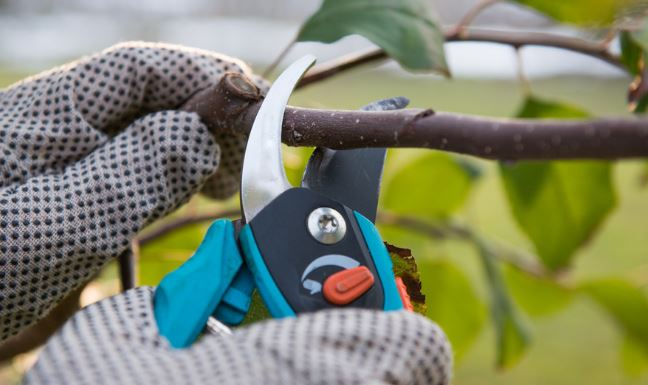Gardening is all about nurturing healthy plants, and it all starts with effective tool maintenance. Your pruning shears might look like another gardening tool under the shed, but they can act as a host for a variety of pests and plant diseases if not cleaned properly.
You can’t see the tiny pathogens that cling to these blades. So, even if your plants look healthy, it’s crucial to clean pruning shears between cuts.
In this blog post, you’ll discover 4 effective and easy ways to disinfect your garden tools, including pruning shears, so that you can keep your garden safe and flourishing.
Let’s dive in.
Why Disinfecting Pruning Shears
Cleaning and disinfecting your pruning blades help prevent the spread of common plant diseases like spider mites, powdery mildew, and downy mildew. In addition, it:
- Prolongs the tool’s lifespan by preventing the build-up of rust and debris
- Makes your work more convenient and effective (Sharper tools cut better)
When to Disinfect a Pruning Shear?
Remember that it’s important to frequently disinfect all the tools that directly come in contact with the plants. The right frequency depends on:
- How often do you use these shears
- And, the presence of pests or diseases in your garden
As a rule of thumb, you should disinfect your pruning shears at least once a year, ideally in spring or fall. Meanwhile, clean your pruning shear between each use if you notice any signs of active infection, such as powdery mildew.
How to Disinfect Pruning Shears
Not all methods are effective and safe for disinfecting a pruning shear. While it may be tempting to use common household cleaners like Lysol or Listerine, there is no scientific evidence that they can help remove plant pathogens.
Plus, these cleaning agents can even corrode the metallic parts of your gardening tools, reducing their effectiveness and lifespans. The good thing is most of the disinfectants we’ll cover below are readily available.
4 Effective Ways to Clean Pruning Shears
Here are 4 ways to disinfect a pruning shear easily and effectively.
Rubbing Alcohol
Rubbing alcohol is probably the most budget-friendly way to disinfect any gardening tool. Plus, it's available in most stores and pharmacies.
Not all rubbing alcohols are suitable for this application though. The best one is 70% Isopropyl Alcohol (IPL) as it's effective against plant pathogens, readily available, and safe to use on most tools.
Since rubbing alcohol works faster than most other disinfectants, it's ideal for quickly cleaning pruning shears between plants.
There are generally two ways to apply alcohol to a pruning tool:
- With a spray bottle
- Wipe the pruning shear with a damp cloth
Alcohol evaporates quickly, so you just need to leave the tool for about 30 seconds before storing or using it again.
Hydrogen Peroxide
Hydrogen peroxide (H202) is another effective disinfectant for pruning shears. A 3% solution (3% hydrogen peroxide and 97% water) is commonly available in general stores and pharmacies and works well against pathogens.
You can use hydrogen peroxide to disinfect a shear in two ways:
- Spray or wipe the solution on your tool
- Immerse the shear in a hydrogen peroxide solution
Note that hydrogen peroxide usually takes 5 - 10 minutes to work. This means it’s not an ideal solution for disinfecting pruning shears on the go or in between plants. But, it’s perfect if you need to effectively clean your blades at the end of the season.
You May Also Like: 7 Pruning Facts Every Gardener Should Know
Bleach
You can also use bleach to disinfect gardening tools, but it doesn’t work as fast as hydrogen peroxide and rubbing alcohol.
Here’s how you can use bleach to disinfect pruners:
- Start by creating a 10% bleach solution, which consists of 1 part bleach and 9 parts water
- Immerse pruning shears in the solution for 30 minutes
- Remove and allow them to air dry
Since bleach takes longer to work, it’s not ideal for disinfecting gardening equipment on the go. However, it’s ideal for bulk cleaning. A word of caution: Always use gloves when you use bleach as it can cause skin damage.
Heat
It's a known fact that excessive heat kills pathogens on almost any surface. Your gardening shears are no exception.
To disinfect a hand pruner, you can use boiling water or steam.
But, there are a few downsides to using this method:
- It takes longer than other methods (Around 30 minutes at 180 to 200 F)
- The tools must be small enough to fit on a stovetop or oven
- It’s not suitable for tools that have plastic as it typically melts at high temperatures
Using the Right Tools
For gardeners with limited hand mobility, it can be a bit difficult to disinfect gardening tools. Start by selecting the right pruning shear. An ergonomic shear will help you:
- Be a more effective and efficient gardener
- Minimize strain on your hands and wrists
Recommended product: Bypass Pruner - Premium Pruning Shears for Garden
For added convenience, use a battery-powered, electric sprayer so that you don’t have to pump the solution manually. Also, use gloves with built-in grips to make the process easier and more effective.
FAQs About Disinfecting Pruning Shears
Can I Use Clorox Wipes to Clean Pruning Shears?
Yes, you can use Clorox wipes as a quick fix to clean some pathogens and remove surface dirt. However, it’s not an effective long-term solution because the chemicals may cause corrosion over time, reducing the tool’s life.
What is the Best Disinfectant for Garden Tools?
70% isopropyl alcohol is probably the best option as it’s effective against most pathogens, relatively safe to use, and does the job quickly. Alternatively, a 10% bleach solution (1:9 ratio) works well.
Should I Oil My Pruning Shears?
Yes, oiling a pruning shear after cleaning and disinfecting helps protect it against rust. You can apply a light coat of a tool lubricant or machine oil to the blades.
Can I Use Vinegar to Clean Pruning Shears?
Vinegar is a common household cleaner, but it's not a good option for disinfecting pruning shears because it's not effective against pathogens. Plus, its acidic nature can damage the metal surfaces over time.
Conclusion
Keeping your gardening tools clean, disinfected, and sharp isn’t just good tool maintenance - it’s essential for protecting your plants and helping them thrive.
By following a simple disinfection routine, you not only prevent the spread of harmful diseases but also extend the life of your tools, ensuring they work seamlessly for seasons to come.
You May Also Like: How to Sharpen Pruning Shears


